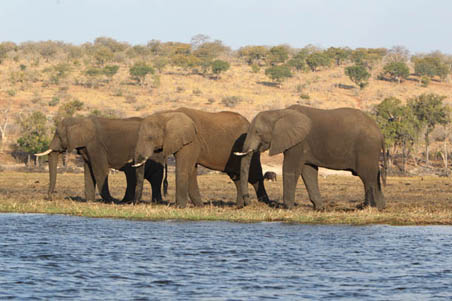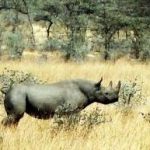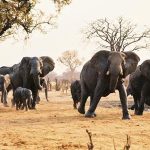The elephants of the Selous need help, and hunting is critical to their survival.
When Benson Kibonde left his position as chief warden of the Selous Game Reserve in Tanzania in 2008 he thought the days of rampant ivory poaching in Tanzania were long past.
A 1976 survey showed that there were 110,000 elephants in the Selous, but by the mid-1980s that number had been cut in half, and if poaching continued at that rate elephants likely would be completely wiped out in the reserve by the early 1990s. But in 1987, the Frankfurt Zoological Society stepped in and provided the funding necessary to wage a full-on war on the gangs of poachers operating in the Selous. The condition of that funding, though, was that a retention program be put in place so that half of the funds generated by the reserve (85 percent of which came from hunting) would be returned to the park to aid in anti-poaching efforts through the purchase of new equipment and by providing salaries for rangers. This agreement became Tanzania’s first community-based conservation program, and it turned the tide on poaching. The 1989 survey showed that there were approximately 30,000 elephants in the reserve. By 2006 that number had more than doubled to 70,000.
Kibonde was integral in these restoration efforts, and by the time he retired as chief warden in 2008 after having served in that position since 1994, he felt certain that the future of elephants in the Selous was vouchsafed. He transferred to a training facility in northern Tanzania where he instructed young game scouts, but in 2012 he was called back to the Selous by the Tanzanian government. What he found was appalling.
Infrastructure in the reserve had almost completely collapsed during his four-year absence and the scout vehicles, many of which were aged when Kibonde left the park, were in a state of disrepair. The 250 scouts who were asked to cover 21,000 acres of land hadn’t been paid in months (the funds generated by the retention fund, as established in 1987, had been put on hold). Each scout was working just ten days a month, so the doors of the Selous lay wide open to poachers.
Kibonde was shocked. Morale was low, local poachers were bragging about their exploits and getting rich, and the Selous elephant population was once again being depleted. Kibonde knew he had to act quickly.
“After assessing the situation, I raised an alarm with the conservation partners, particularly the hunting companies,” Kibonde said in an article in Hunter’s Path in 2015. “I requested them to come to our assistance by waging an all-out war against poaching.”
With the help of hunting companies operating in the reserve, Kibonde almost single-handedly began righting the ship in the Selous. He recruited scouts from the Pasanisi Training College and, through donations and government assistance, ensured that they were getting paid. His teams began by refurbishing the out-of-commission vehicles and started opening roads back into the reserve that would allow scouts to engage poachers. The number of scouts climbed from 250 to 680, and they began working twenty days a month instead of ten, which meant that the number of patrol days in the park rose from 30,000 in 2008 to more than 163,000 in 2014. The patrol units are now based in permanent camps in the reserve, and in areas where there are large numbers of elephants the camps are positioned at close intervals that allow anti-poaching teams to respond quickly to any illegal hunting in the park. The number of vehicles was raised from twenty to forty, and by the end of 2016 Kibonde hopes that he will have sixty vehicles in place. Since his return, he and his team have refurbished six road graders and nine heavy trucks to ease scout movement in the park.
The German Development Bank is scheduled to provide additional funding, and until it does the Selous Elephant Emergency Project (SEEP) has been established as a stopgap to help contain poaching until funding resumes. The advances Kibonde has made are not welcomed by everyone, particularly the poachers, who just a short time ago had free range in many parts of the reserve. There have been confrontations over the last several years, and some of Kibonde’s scouts have been injured, but he says the message to the poachers is clear and pointed.
“We taught the poachers a lesson that we would no longer tolerate their self-imposed immunity to the conservation laws,” says Kibonde.
Based on the late 2014 census of elephants in the park, Kibonde’s work has helped elephant populations rebound. That’s thanks in large part to the hunting community, which helped support Kibonde’s efforts on the ground in the reserve.
“The hunting companies have contributed to our efforts against poaching and are still contributing a lot,” Kibonde says. “Some have provided vehicles, others funds for paying monthly allowances for 100 volunteers, while some have supported us by making their vehicles available for transporting scouts to patrol areas. I thank all those who have participated in this painstaking struggle.”
Kibonde is a major proponent of sport hunting for elephants and says that hunting and the funds it generates are critical to the survival of the elephants of the Selous.
“It is imperative that tourist hunting continues in the Selous for two main reasons. The first reason is that hunting companies and hunters have helped to control the poaching situation in the reserve through direct involvement. Secondly, 85 percent of the Selous retention scheme funds come from hunting. If any amount of the hunting revenue is compromised, the registered success in anti-poaching efforts could be seriously jeopardized.”
In 2014 the U.S. Fish & Wildlife Service banned importation of sport-hunted ivory from Tanzania, a ban that, Kibonde says, is a major blow to elephant conservation in the reserve.
“This move is a disaster for the Selous, as most of its income is directly or indirectly dependent on elephant hunting,” says Kibonde. “If our remaining 15,000 elephants are wiped out in the very near future, this ban would be a major reason.”
The future of elephants in the Selous and across Tanzania depends upon how closely international governments heed Kibonde’s words. To stem the tide of poaching, he says, he needs hunting and the funds it generates. In 2013, Kibonde officially retired, but he has remained in the Selous working to ensure that the borders of the park are safeguarded against poachers who would wipe out elephants for immediate financial gain.
To learn more about SEEP, visit cic-wildlife.org.












